A Study on Economic Evaluation of Design Elements of Zero-Energy Buildings According to Energy Consumption and Production
Abstract
1. Introduction
2. Preliminary Review
2.1. Review of the ZEB Design Process
2.2. Previous Studies on Economic Evaluation
3. Energy and Economic Analysis Model
3.1. Reference Model for Economic Evaluation of ZEB Design Elements
3.2. Simulation Model for Energy and Economic Analysis
3.3. Specification of Solar System for Simulation
3.4. Simulation Concept
4. Energy Consumption Analysis
4.1. Energy Consumption According to the Passive Elements
4.2. Energy Production According to the Active Elements
4.3. Final Energy Consumption
5. Economic Evaluation
5.1. Energy Consumption According to Window Replacement
5.2. Changes in Investment Costs Due to Window Changes
5.3. Changes in Investment Cost According to Solar Power Generation Equipment
5.4. Changes in the Amount of Electricity Generated by Solar Power Investment in Window Investment Costs
6. Conclusions
- (1)
- The variation in roof area, contingent upon the building type, directly impacts the energy production of the solar system. Consequently, elementary schools exhibit a higher rate of energy consumption reduction compared to large offices.
- (2)
- Although there is a small disparity in energy production among regions, the variation in energy consumption due to passive factors is substantial. Consequently, the final energy consumption of buildings located in the southern region of Republic of Korea is further reduced compared to those situated in the central region.
- (3)
- In regions with lower average temperatures such as the central region, changes in energy consumption are more pronounced in response to alterations in window heat transmittance. Hence, in the case of the central region, it has been verified that investing in passive elements such as windows is more justified than investing in active elements like solar systems.
- (4)
- Solar energy production is directly influenced by regional insolation levels and building orientation. Simulation results confirm that in regions with high solar radiation, such as the southern region, investing in active elements proves to be more cost-effective than investing in passive elements.
Author Contributions
Funding
Institutional Review Board Statement
Informed Consent Statement
Data Availability Statement
Conflicts of Interest
References
- Kim, M.G.; Kang, H.S. A Study on Design Application of Eco-Friendly Integrated Design Process. J. Korea Inst. Ecol. Archit. Environ. 2013, 132, 87–94. [Google Scholar]
- Tae, Y.R. Architectural Design Process by the Changes of Sustainable Design Guidelines of Public Project. J. Korean Sol. Energy Soc. 2010, 30, 63–70. [Google Scholar]
- Kim, S.H. A Study for Building Design Process Using Ecological Approach. Master’s Dissertation, Graduate School of Sungkyunkwan University, Seoul, Republic of Korea, 2002. [Google Scholar]
- International Energy Agency. Integrated Design Process: A Guideline for Sustainable and Solar-Optimized Building Design; International Energy Agency: Paris, France, 2003. [Google Scholar]
- Sahib, Y. Modernizing Building Energy Codes 2013. In The International Energy Agency Policy Pathway Series; International Energy Agency: Paris, France, 2013; pp. 24–28. [Google Scholar]
- Choi, W.K.; Kim, H.J.; Suh, S.J. A Study on the Analysis of Energy Consumption Patterns According to the Building Shapes with the Same Volume. J. Korean Sol. Energy Soc. 2007, 27, 103–109. [Google Scholar]
- Lee, B.Y.; Kim, K.H. A Study on the Integrated Design Process for Sustainable Architecture. J. Archit. Inst. Korea 2009, 25, 55–62. [Google Scholar]
- Lee, S.M.; Lee, T.K.; Kim, J.U. A Study on the Design Method of Zero Energy Building considering Energy Demand and Energy Generation by Region. J. Archit. Inst. Korea 2018, 34, 13–22. [Google Scholar]
- Lee, S.M.; Park, S.H. Zero-Energy Building Integrated Planning Methodology and Verification Considering Passive and Active Environmental Control Method. Appl. Sci. 2021, 11, 3686. [Google Scholar] [CrossRef]
- Lee, H.J. A Study on the Energy Self-Sufficient House. Master’s Dissertation, Graduate School of Semyung University Graduate School, Chungbuk, Republic of Korea, 2016. [Google Scholar]
- Rodriguez-Ubinas, E.; Rodriguez, S.; Voss, K.; Todorovic, M.S. Energy efficiency evaluation of zero energy houses. Energy Build. 2014, 83, 23–35. [Google Scholar] [CrossRef]
- University of British Columbia. UBC Integrated Design Process. 2020. Available online: https://planning.ubc.ca/sustainability/sustainability-action-plans/green-building-action-plan/institutional-building-requirements/ubc-integrated-design-process (accessed on 1 April 2023).
- Yoon, S.H.; Song, S.B.; Kim, Y.T.; Yum, S.K. Energy Saving Effects according to the Window Performance for an Apartment House and Estimation of the Window Economical Efficiency. J. Archit. Inst. Korea 2008, 24, 321–330. [Google Scholar]
- Lee, H.S.; Park, J.W.; Yoon, J.H.; Shin, W.C. A Study on the Economic Evaluation of Photovoltaic System in the Greenhome. J. Korean Sol. Energy Soc. 2013, 33, 47–52. [Google Scholar]
- Illuminating Engineering Society of North America. Energy Standard for Buildings Except Low-Rise Residential Buildings; American National Standards Institute/American Society of Heating, Refrigerating and Air-Conditioning Engineers: Atlanta, GA, USA, 2019. [Google Scholar]
- Chang, W.S.; Shin, H.C.; Choi, W.K. Energy Sensitivity Analysis According to the Design Variables with the Same Volume Building. J. Korean Inst. Archit. Sustain. Environ. Build. Syst. 2014, 8, 104–110. [Google Scholar]
- Wang, R.; Lam, C.M.; Alvarado, V.; Hsu, S. A modeling framework to examine photovoltaic rooftop peak shaving with varying roof availability: A case of office building in Hong Kong. J. Build. Eng. 2021, 44, 103349. [Google Scholar] [CrossRef]
- Peres Suzano e Silva, A.C.; Calili, R.F. New building simulation method to measure the impact of window-integrated organic photovoltaic cells on energy demand. Energy Build. 2021, 252, 111490. [Google Scholar] [CrossRef]
- Lee, M.J.; Kim, W.S.; Lee, W.J.; Lee, W.T. A Study about Reduction Rates of Building Energy Demand for a Detached House according to Building Energy Efficient Methods. J. Archit. Inst. Korea 2012, 28, 275–283. [Google Scholar]
- Hong, W.P. Economic Analysis and Energy Saving Evaluation for Smart Grid System of Hospital Building. J. Korean Inst. Illum. Electr. Install. Eng. 2010, 24, 129–139. [Google Scholar]
- Jang, H.J.; Park, J.C. A Study on the Energy Efficiency Evaluation of Zero Energy Building. J. Korean Inst. Archit. Sustain. Environ. Build. Syst. 2010, 4, 149–156. [Google Scholar]
- Hoseinzadeh, P.; Assadi, M.K.; Heidari, S.; Khalatbari, M.; Saidur, R.; Sangin, H. Energy performance of building integrated photovoltaic high-rise building: Case study, Tehran, Iran. Energy Build. 2021, 235, 110707. [Google Scholar] [CrossRef]
- Peippo, K.; Lund, P. Multivariate optimization of design trade-offs for solar low energy buildings. Energy Build. 1999, 29, 189–205. [Google Scholar] [CrossRef]
- Zogou, O.; Stapountzis, H. Energy analysis of an improved concept of integrated PV panels in an office building in central Greece. Appl. Energy 2011, 88, 853–866. [Google Scholar] [CrossRef]
- Azami, A.; Sevinç, H. The energy performance of building integrated photovoltaics (BIPV) by determination of optimal building envelope. Build. Environ. 2021, 199, 107856. [Google Scholar] [CrossRef]
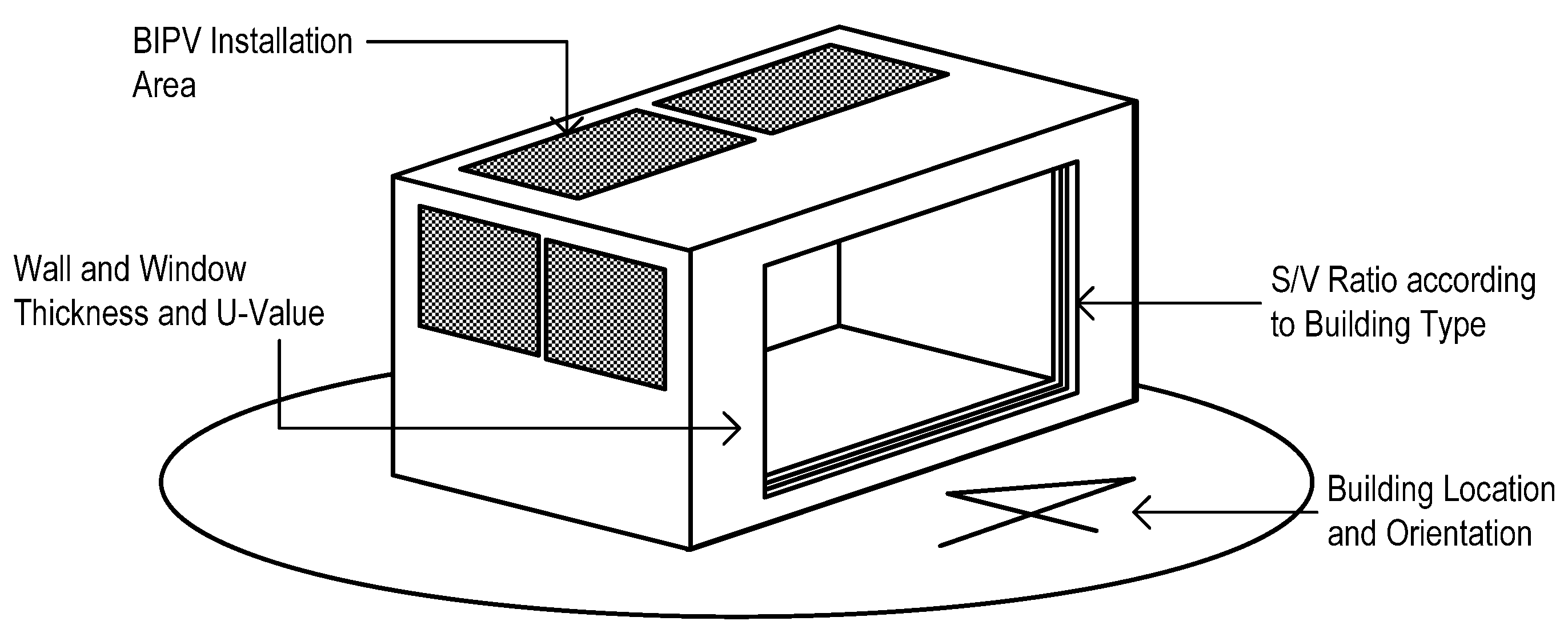


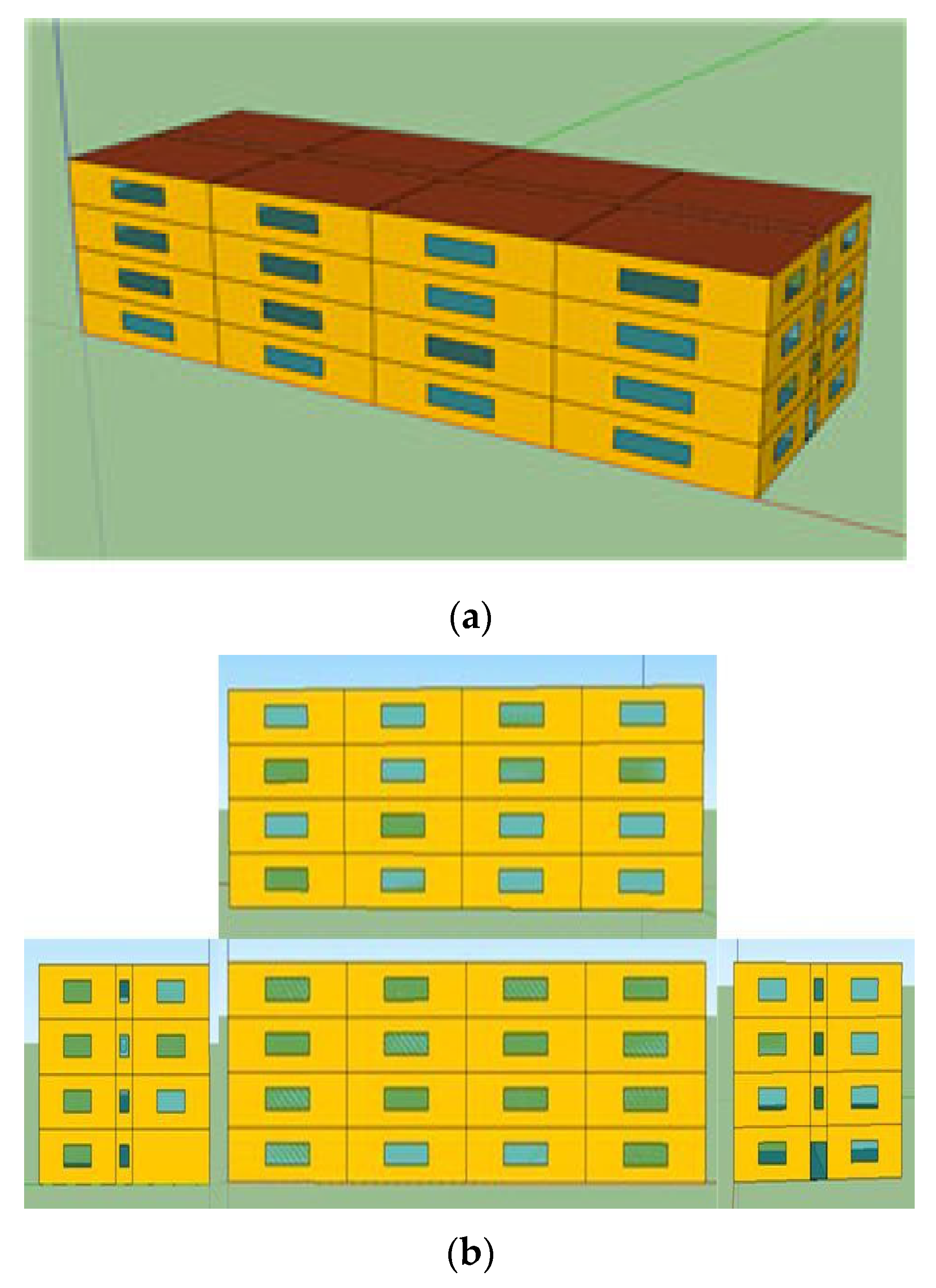

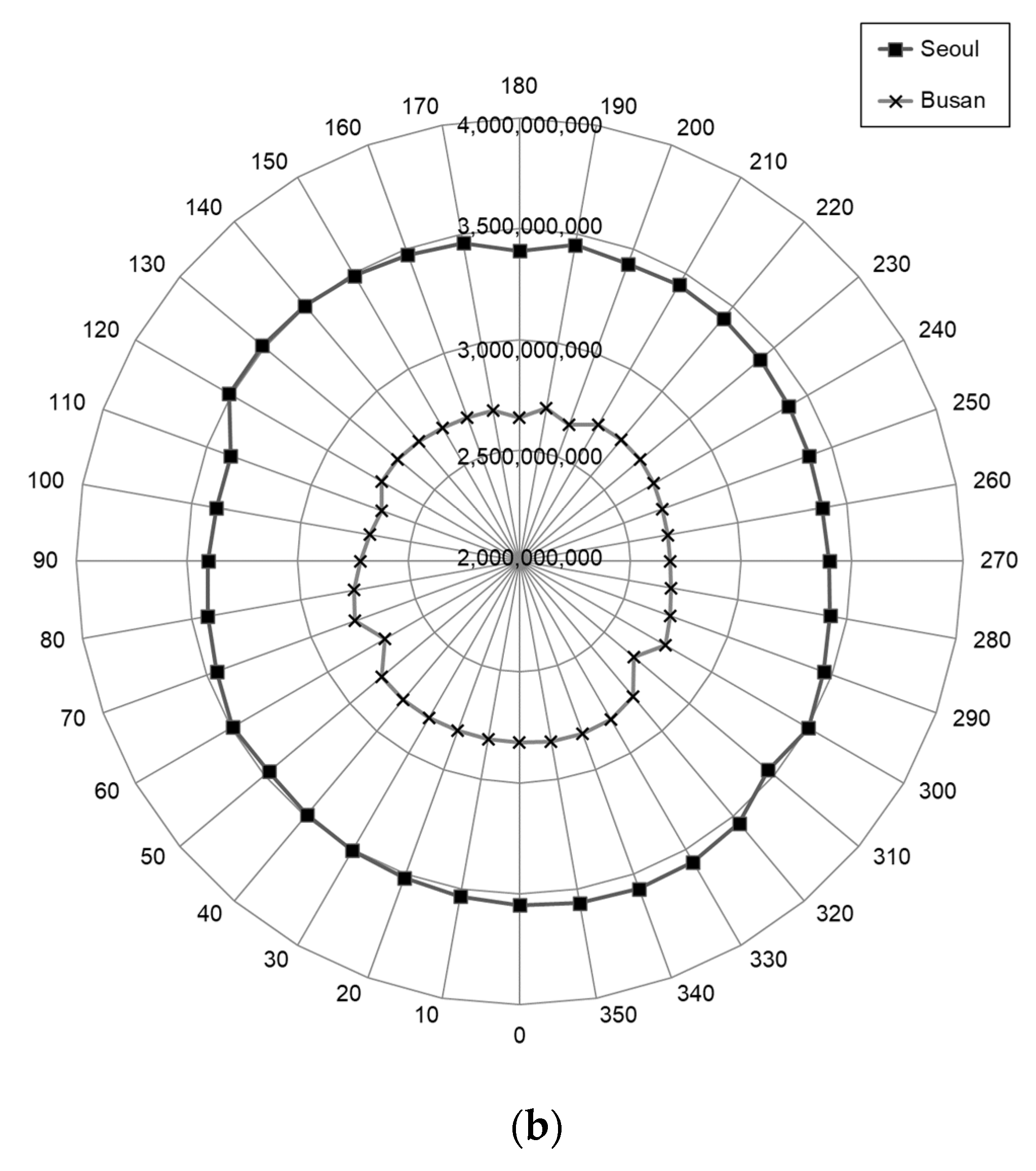
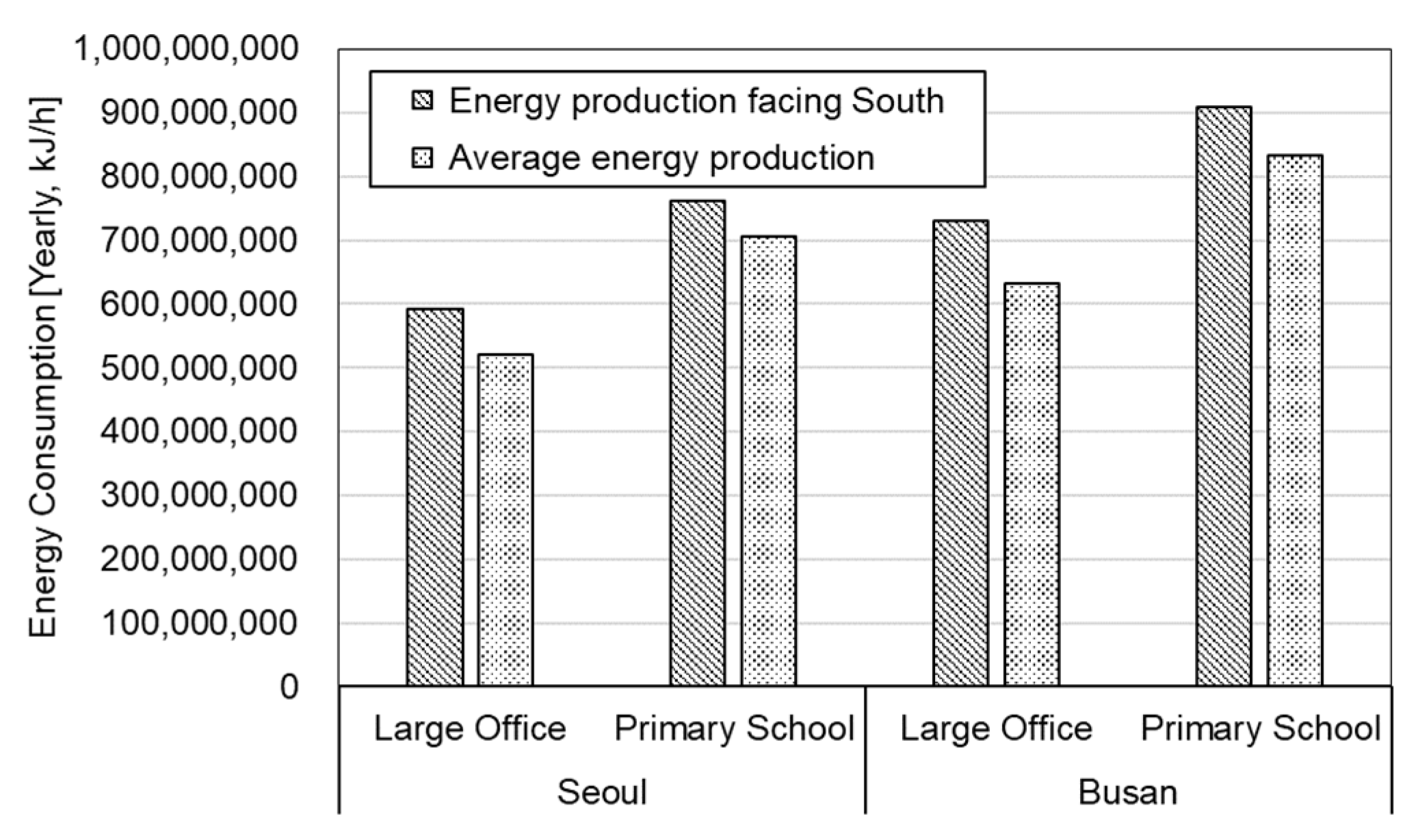
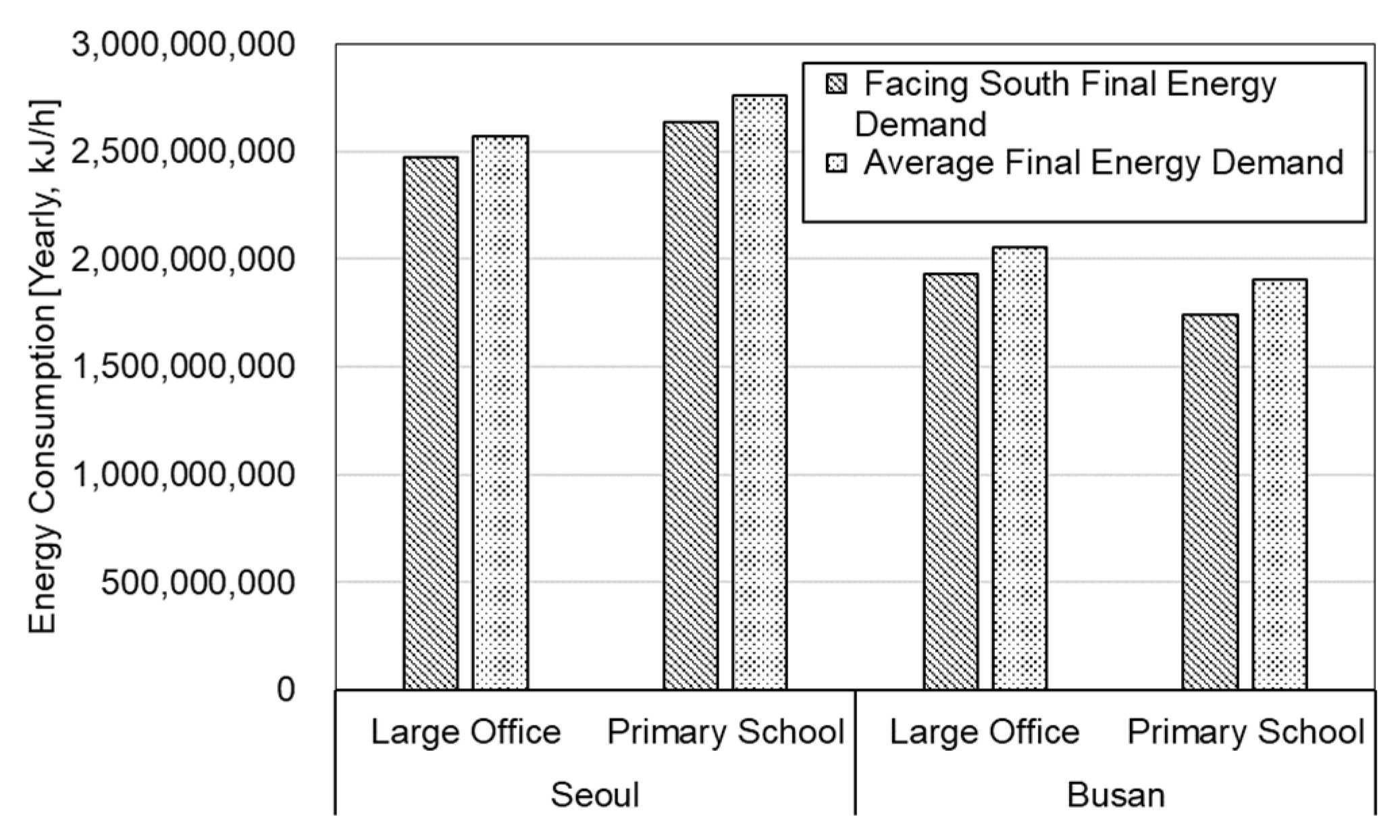
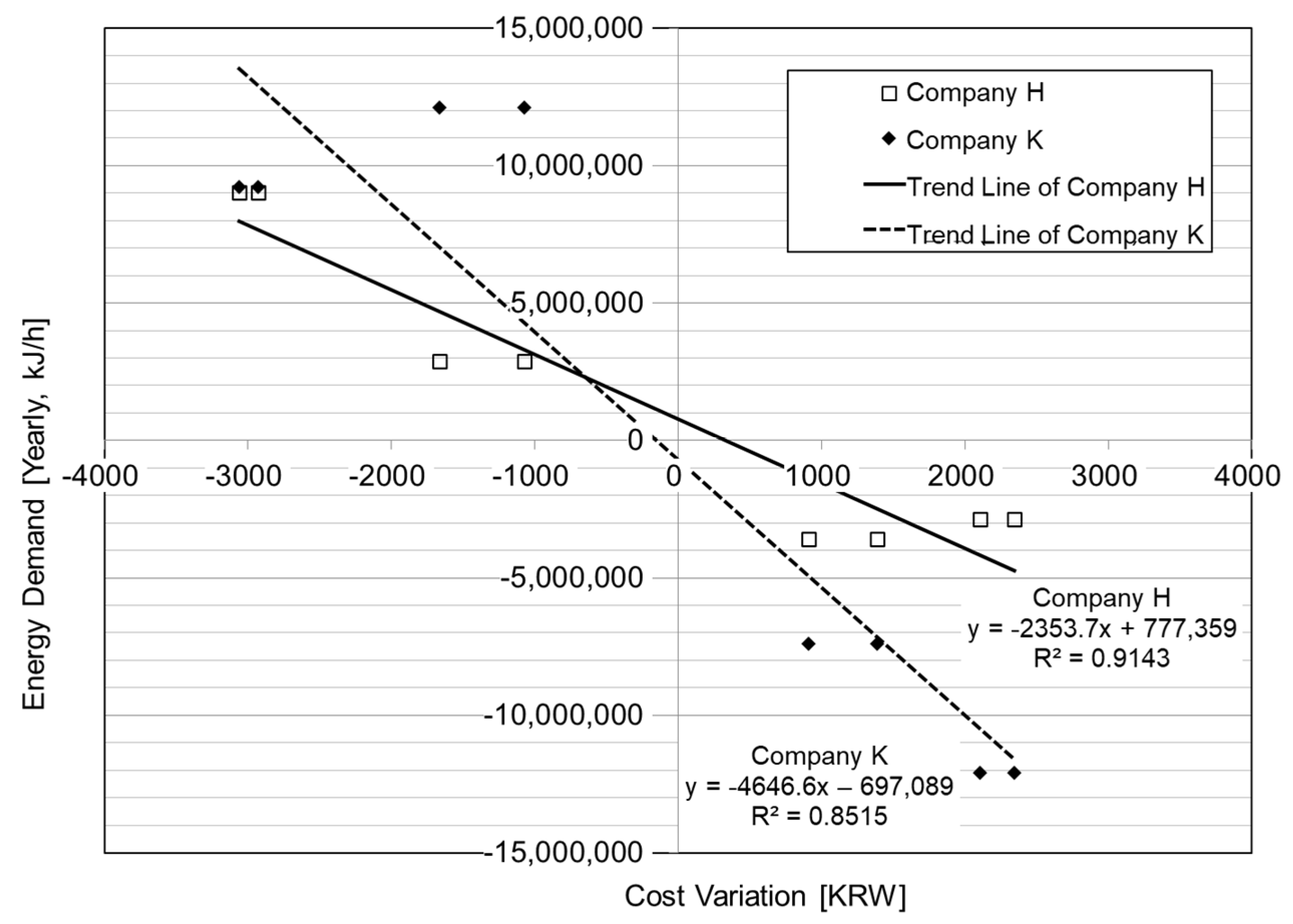
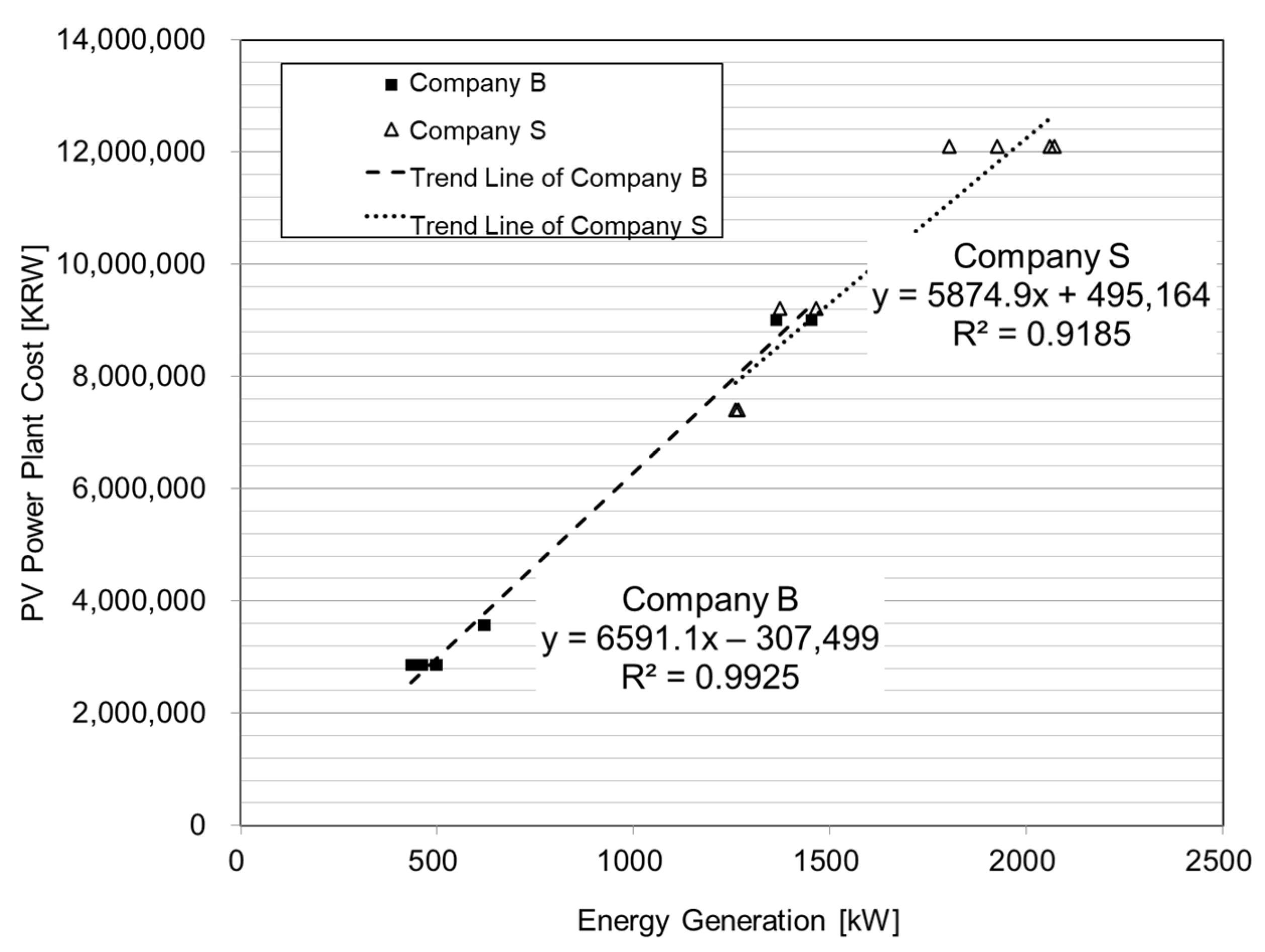
| Building Type | Total Floor Area (m2) | Number of Floors |
|---|---|---|
| Large Office | 46,320 | 12 |
| Medium Office | 4982 | 3 |
| Small Office | 511 | 1 |
| Warehouse | 4835 | 1 |
| Stand-alone Retail | 2319 | 1 |
| Strip Mall | 2090 | 1 |
| Primary School | 6871 | 1 |
| Secondary School | 19,592 | 2 |
| Supermarket | 4181 | 1 |
| Quick Service Restaurant | 232 | 1 |
| Full Service Restaurant | 511 | 1 |
| Hospital | 22,422 | 5 |
| Outpatient Health Care | 3804 | 3 |
| Small Hotel | 4013 | 4 |
| Large Hotel | 11,345 | 6 |
| Midrise Apartment | 3135 | 4 |
| Properties | Large Office | Primary School | |
|---|---|---|---|
| Floor area (m2) | Original | 46,320 | 6871 |
| Modified | 3656 | 7312 | |
| Floors (Story height = 4 m) | Original | 12 | 1 |
| Modified | 4 | 2 | |
| Total floor area (m2) | 14,624 (3656 × 4) | 14,624 (7312 × 2) | |
| Volume (m3) | 58,496 (3656 × 4 × 4) | 58,496 (7312 × 4 × 2) | |
| Surface area (m2) | Wall | 6073 | 10,667 |
| Window | 1523 | 1677 | |
| Roof | 3656 | 7312 | |
| Floor | 3656 | 7312 | |
| S/V ratio | 0.25 | 0.46 | |
| Properties | Condition | |
|---|---|---|
| Building Volume (m3) | 9651.56 | |
| Floor Area (m2) | 783.73 | |
| Floors | 4 | |
| Households Number | 8 for each story | |
| Area of each Households (m2) | 88.24 | |
| Common Area (m2) | 311.27 | |
| Window-to-Wall Ratio (%) | Southern | 14.7 |
| Western | 13.5 | |
| Northern | 14.7 | |
| Eastern | 14.6 | |
| Building Type | Rooftop PV | BIPV | ||||||
|---|---|---|---|---|---|---|---|---|
| Area (%) | Capacity (kW) | South Facade | West Facade | East Facade | ||||
| Area (%) | Capacity (kW) | Area (%) | Capacity (kW) | Area (%) | Capacity (kW) | |||
| Large Office | 70 | 256.5 | 30 | 62.7 | 30 | 41.8 | 30 | 41.8 |
| Primary School | 70 | 513.0 | 30 | 43.7 | 30 | 26.6 | 30 | 34.2 |
| Properties | Wall Type | Total Thickness (m) | U-Value (W/m2K) | ||
|---|---|---|---|---|---|
| Seoul | Busan | Seoul | Busan | ||
| Large Office | Adjacent Ceiling | 0.358 | 0.330 | 0.220 | 0.260 |
| Adjacent Wall | 0.207 | 0.178 | 0.360 | 0.450 | |
| Exterior Roof | 0.480 | 0.420 | 0.150 | 0.180 | |
| Exterior Wall | 0.270 | 0.213 | 0.260 | 0.320 | |
| Ground Floor | 0.430 | 0.370 | 0.220 | 0.250 | |
| Window | 0.026 | 0.026 | 1.400 | 2.300 | |
| Primary School | Adjacent Ceiling | 0.358 | 0.330 | 0.220 | 0.260 |
| Adjacent Wall | 0.207 | 0.178 | 0.360 | 0.450 | |
| Exterior Roof | 0.480 | 0.420 | 0.150 | 0.180 | |
| Exterior Wall | 0.270 | 0.213 | 0.260 | 0.320 | |
| Ground Floor | 0.430 | 0.370 | 0.220 | 0.250 | |
| Window | 0.026 | 0.026 | 1.400 | 2.300 | |
| Properties | Heating Energy | Cooling Energy | Latent Heat Energy | Sum of Energy Demand | |
|---|---|---|---|---|---|
| Large Office | Seoul | 2,323,063,516 | 364,261,629 | 402,608,542 | 3,089,933,688 |
| Busan | 1,642,495,287 | 728,342,476 | 313,254,886 | 2,684,092,649 | |
| Primary School | Seoul | 2,908,380,002 | 126,817,459 | 432,126,624 | 3,467,324,085 |
| Busan | 2,072,689,046 | 319,291,962 | 342,133,536 | 2,734,114,545 | |
| Difference Value | Seoul | 585,316,486 | −237,444,170 | 29,518,082 | 377,390,398 |
| Busan | 430,193,759 | −409,050,514 | 28,878,651 | 50,021,896 | |
| Properties | Type | Large Office | Primary School | ||
|---|---|---|---|---|---|
| Location | Seoul | Busan | Seoul | Busan | |
| Maximum energy production | Energy Production [kJ/h] | 600,004,585 | 747,771,046 | 762,676,316 | 914,300,619 |
| Orientation [°] | 90 | 90 | 100 | 100 | |
| Minimum energy production | Energy Production [kJ/h] | 434,560,713 | 506,904,344 | 646,663,522 | 745,810,532 |
| Orientation [°] | 230 | 250 | 260 | 260 | |
| Region and Building Type | Average of Energy Demand | Average of Energy Generation | Final Average of Energy Demand | |
|---|---|---|---|---|
| Seoul | Large Office | 3,089,933,688 | 520,313,958 | 2,569,619,730 |
| Primary School | 3,457,324,085 | 706,353,309 | 2,760,970,777 | |
| Difference of two values | 11% | 26% | 7% | |
| Primary School | Large Office | 3,502,698,245 | 644,985,657 | 2,857,712,588 |
| 3,198,209,746 | 2,553,224,089 | |||
| Primary School | 3,661,348,225 | 852,889,824 | 2,808,458,401 | |
| 3,347,944,446 | 2,495,054,622 | |||
| Difference of two values | 4% | 24% | 2% | |
| 4% | 2% | |||
| Difference due to U-value change | 9% | - | - | |
| 9% | ||||
| Busan | Large Office | 2,684,092,649 | 631,502,370 | 205,590,279 |
| Primary School | 2,734,114,545 | 832,022,840 | 1,902,091,705 | |
| Difference of two values | 2% | 24% | 7% | |
| Simulation Case | U-Value [W/m2K] | Sum of Energy Demand [kWh] | ||||||
|---|---|---|---|---|---|---|---|---|
| Adjacent Ceiling | Adjacent Wall | Exterior Roof | Exterior Wall | Ground Floor | Window | |||
| Seoul | A | 0.210 | 0.240 | 0.150 | 0.170 | 0.170 | 1.150 | 85,732 |
| B | 0.210 | 0.240 | 0.150 | 0.170 | 0.170 | 1.000 | 83,628 | |
| C | 0.210 | 0.240 | 0.150 | 0.170 | 0.170 | 0.880 | 80,565 | |
| Incheon | D | 0.210 | 0.240 | 0.150 | 0.170 | 0.170 | 1.150 | 88,317 |
| E | 0.210 | 0.240 | 0.150 | 0.170 | 0.170 | 1.000 | 85,971 | |
| F | 0.210 | 0.240 | 0.150 | 0.170 | 0.170 | 0.880 | 83,043 | |
| Gwangju | G | 0.260 | 0.310 | 0.180 | 0.220 | 0.220 | 1.510 | 94,330 |
| H | 0.260 | 0.310 | 0.180 | 0.220 | 0.220 | 1.150 | 92,943 | |
| I | 0.260 | 0.310 | 0.180 | 0.220 | 0.220 | 1.000 | 91,280 | |
| Busan | J | 0.260 | 0.310 | 0.180 | 0.220 | 0.220 | 1.510 | 82,366 |
| K | 0.260 | 0.310 | 0.180 | 0.220 | 0.220 | 1.150 | 81,457 | |
| L | 0.260 | 0.310 | 0.180 | 0.220 | 0.220 | 1.000 | 80,383 | |
| Simulation Case | Window U-Value [W/m2K] | Manufacturer | Cost [KRW] | |
|---|---|---|---|---|
| Seoul and Incheon | A·D | 1.150 | K | 91,770,149 |
| H | 97,116,420 | |||
| B·E | 1.000 | K | 103,874,126 | |
| H | 99,986,733 | |||
| C·F | 0.880 | K | 113,085,940 | |
| H | 109,004,019 | |||
| Gwangju and Busan | G·J | 1.510 | K | 84,370,083 |
| H | 93,538,733 | |||
| H·K | 1.150 | K | 91,770,149 | |
| H | 97,116,420 | |||
| I·L | 1.000 | K | 103,874,126 | |
| H | 99,986,733 | |||
| Manufacturer | Capacity [kW] | Cost [KRW] |
|---|---|---|
| S | 19.8 | 52,400,000 |
| 25.2 | 66,300,000 | |
| 30 | 79,400,000 | |
| 35.1 | 92,000,000 | |
| 40.5 | 106,100,000 | |
| 45 | 125,000,000 | |
| 50.4 | 136,500,000 | |
| Average | 2,673,577/kW | |
| B | 20.76 | 52,400,000 |
| 25.95 | 66,300,000 | |
| 30.44 | 79,400,000 | |
| 35.98 | 92,000,000 | |
| 40.48 | 106,100,000 | |
| 45.67 | 125,000,000 | |
| 51.90 | 136,400,000 | |
| Average | 2,618,043/kW |
| Simulation Case | Window U-Value [W/m2K] | Energy Demand Sum [kWh] | Manufacturer | Cost [KRW] | |
|---|---|---|---|---|---|
| Seoul | A | 1.150 | 85,732 | K | 91,770,149 |
| H | 97,116,420 | ||||
| B | 1.000 | 83,628 | K | 103,874,126 | |
| H | 99,986,733 | ||||
| C | 0.880 | 80,565 | K | 113,085,940 | |
| H | 109,004,019 | ||||
| Incheon | D | 1.150 | 88,317 | K | 91,770,149 |
| H | 97,116,420 | ||||
| E | 1.000 | 85,971 | K | 103,874,126 | |
| H | 99,986,733 | ||||
| F | 0.880 | 83,043 | K | 113,085,940 | |
| H | 109,004,019 | ||||
| Gwangju | G | 1.510 | 94,330 | K | 84,370,083 |
| H | 93,538,733 | ||||
| H | 1.150 | 92,943 | K | 91,770,149 | |
| H | 97,116,420 | ||||
| I | 1.000 | 91,280 | K | 103,874,126 | |
| H | 99,986,733 | ||||
| Busan | J | 1.510 | 82,366 | K | 84,370,083 |
| H | 93,538,733 | ||||
| K | 1.150 | 81,457 | K | 91,770,149 | |
| H | 97,116,420 | ||||
| L | 1.000 | 80,383 | K | 103,874,126 | |
| H | 99,986,733 | ||||
Disclaimer/Publisher’s Note: The statements, opinions and data contained in all publications are solely those of the individual author(s) and contributor(s) and not of MDPI and/or the editor(s). MDPI and/or the editor(s) disclaim responsibility for any injury to people or property resulting from any ideas, methods, instructions or products referred to in the content. |
© 2023 by the authors. Licensee MDPI, Basel, Switzerland. This article is an open access article distributed under the terms and conditions of the Creative Commons Attribution (CC BY) license (https://creativecommons.org/licenses/by/4.0/).
Share and Cite
Lee, S.; Park, S. A Study on Economic Evaluation of Design Elements of Zero-Energy Buildings According to Energy Consumption and Production. Appl. Sci. 2023, 13, 7309. https://doi.org/10.3390/app13127309
Lee S, Park S. A Study on Economic Evaluation of Design Elements of Zero-Energy Buildings According to Energy Consumption and Production. Applied Sciences. 2023; 13(12):7309. https://doi.org/10.3390/app13127309
Chicago/Turabian StyleLee, Soonmyung, and Sanghoon Park. 2023. "A Study on Economic Evaluation of Design Elements of Zero-Energy Buildings According to Energy Consumption and Production" Applied Sciences 13, no. 12: 7309. https://doi.org/10.3390/app13127309
APA StyleLee, S., & Park, S. (2023). A Study on Economic Evaluation of Design Elements of Zero-Energy Buildings According to Energy Consumption and Production. Applied Sciences, 13(12), 7309. https://doi.org/10.3390/app13127309







